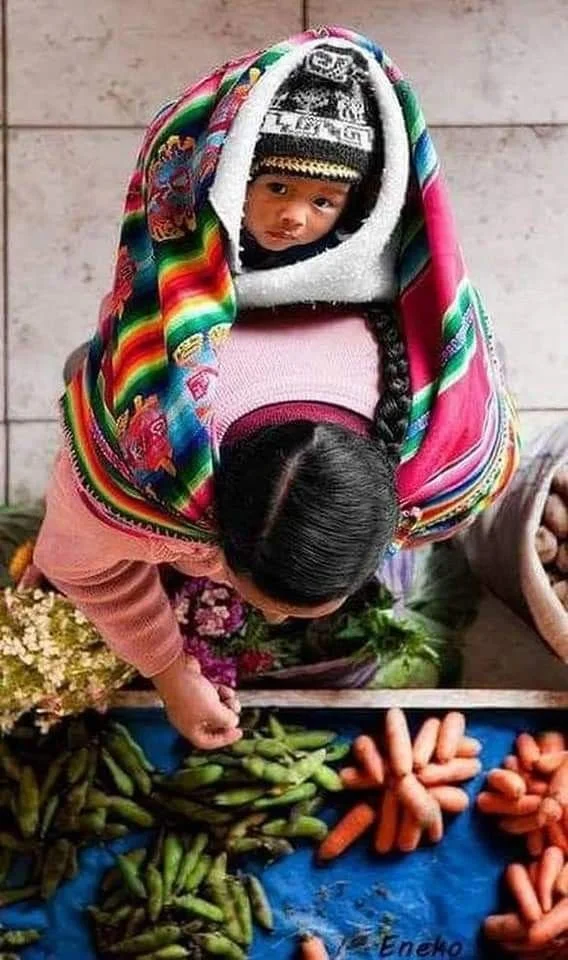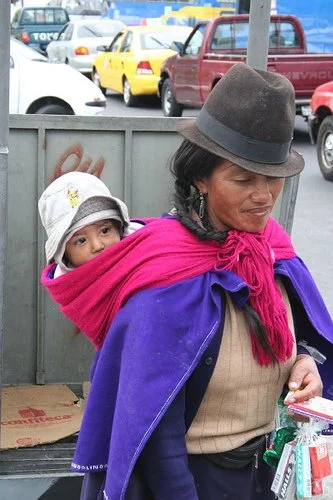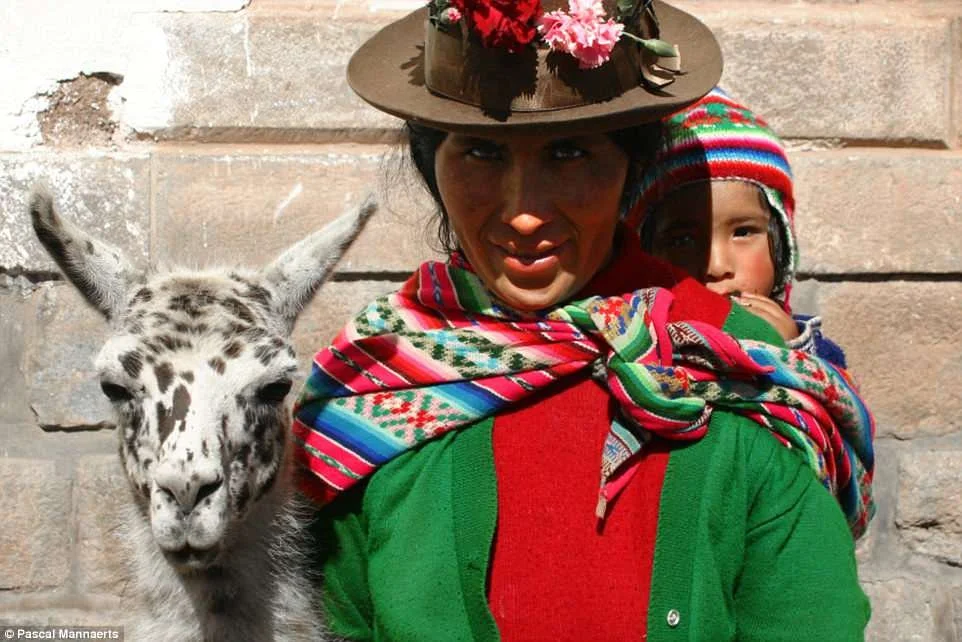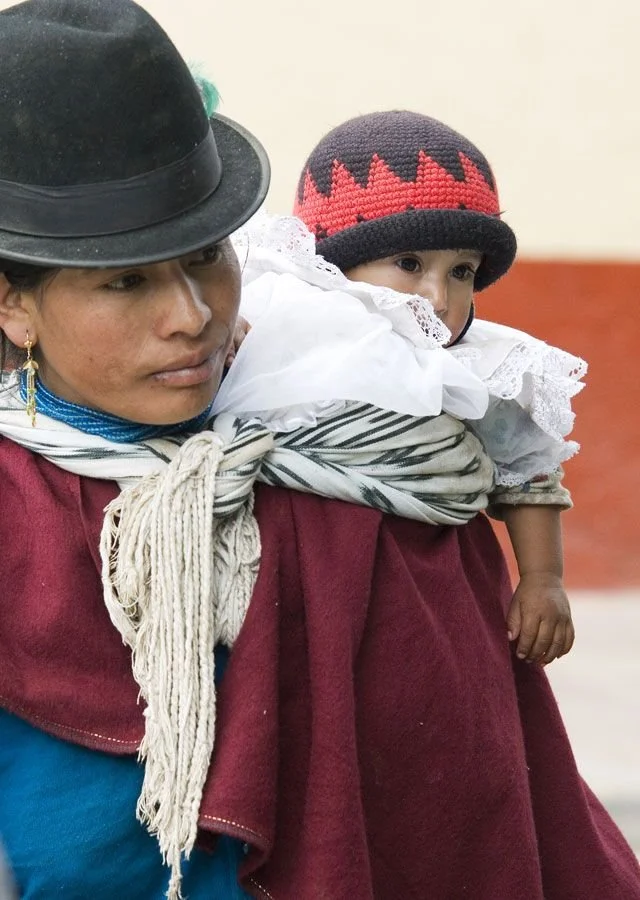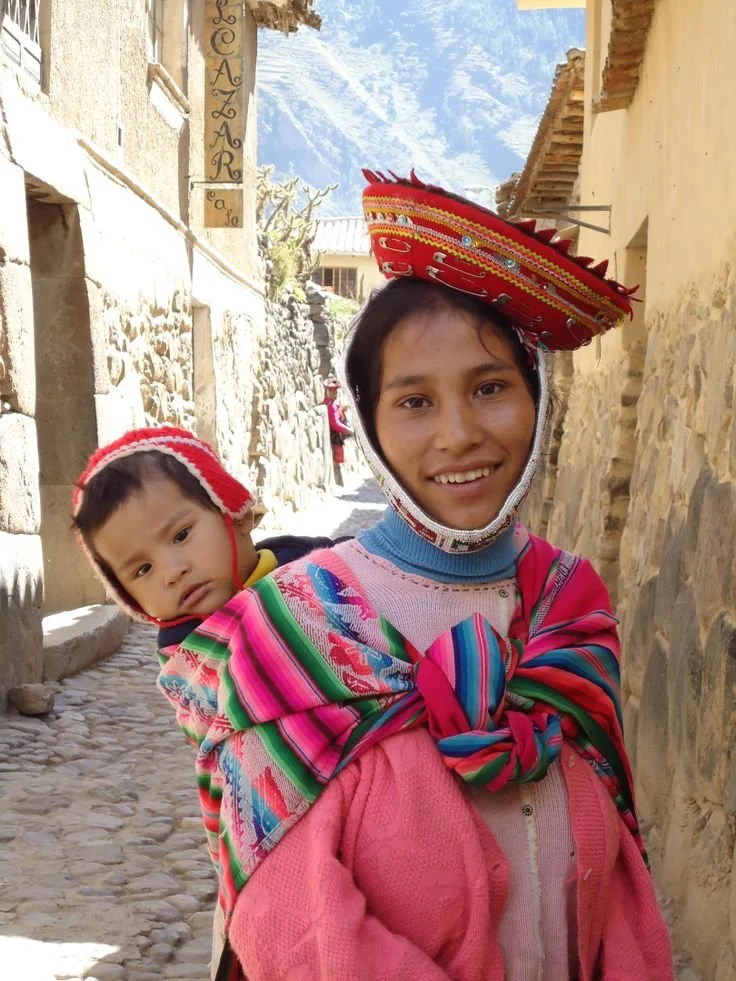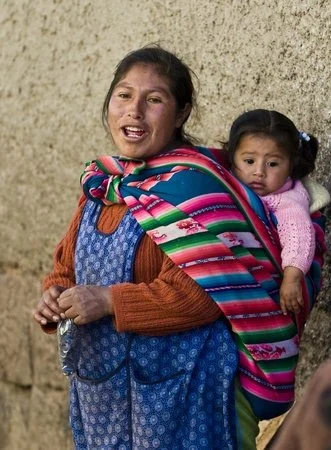The Andes: Mantles, Mountains, and Woven Bonds
In the towering heights of the Andes, babywearing traditions are as vibrant and strong as the mountains themselves. Among Indigenous communities such as the Quechua, Aymara, and Kichwa in Peru, Bolivia, Ecuador, northern Chile, and Argentina, carrying a baby is an act deeply tied to land, ancestry, and textile artistry.
Mothers and caregivers use brightly woven cloths called mantas or aguayos to carry babies high on their backs. These textiles are not just practical items but living stories, woven with symbols that reflect family lineage, agricultural cycles, and spiritual beliefs. Babies wrapped in aguayos ride close to the caregiver's heart, sharing warmth and absorbing the gentle sway of daily tasks — from tending terraced fields to selling goods at bustling markets.
In these highland communities, weaving itself is a sacred act, passed down through generations. Patterns and colors encode knowledge about the natural world and communal identity. By wrapping a baby in a manta, caregivers embed them in this tapestry of stories and relationships from their very first days.
Despite centuries of colonization and cultural suppression, Andean babywearing practices endure as acts of resilience and pride. Today, many families continue to carry their children this way, honoring ancestors and reaffirming the powerful connection between child, caregiver, and the land.
To be carried in the Andes is to feel mountain winds against woven cloth, to hear the quiet hum of earth songs, and to grow up knowing you are forever part of the living weave of community and earth.
In the high Andes of Peru and Bolivia, mothers carry their babies wrapped snugly in bright aguayos, vibrant as the mountain sunsets. Here, a baby peeks out from the folds of woven cloth, eyes wide beneath a warm chullo hat, watching every carrot and bean that passes through their mother’s careful hands. Each color and pattern in the cloth holds stories of ancestors, villages, and celebrations, weaving the child’s first lessons into daily life. In this quiet perch above the market bustle, the baby learns to belong to both the earth and the sky — held close, seen, and always carried forward with love.
In this vibrant image from the Andes region of Peru, a mother carries her baby in a traditional manta (also known as aguayo in some areas). These beautifully woven cloths, often featuring intricate patterns and bold colors, are used to secure babies high on the caregiver’s back, allowing them to stay warm and connected while the mother works or walks. The manta is tied across the chest and shoulders, creating a snug, supportive pouch for the baby. Beyond its practical use, the manta is deeply symbolic, reflecting community identity, cultural heritage, and the importance of closeness between parent and child in Andean life.
In the Andean highlands of Bolivia and Peru, mothers wrap their children in vibrant woven mantas or aguayos, cradling them close as they move through narrow streets and mountain paths. Here, a child peers out from the soft folds, eyes wide and watchful beneath a sun hat. Each step holds the echo of ancient footpaths, each woven thread carrying stories of mountains, ancestors, and quiet lullabies in Quechua or Aymara. In this tender embrace, a child learns the shape of the world from the safe height of a mother’s back — wrapped in warmth, tradition, and unwavering love.
In this joyful image, an Andean mother carries her smiling baby on her back using an aguayo — a beautifully woven rectangular cloth, rich with traditional patterns and colors. This style of carrying, common among Quechua and Aymara families in Peru and Bolivia, keeps the child high and close, allowing them to safely observe the world from their caregiver’s back. The aguayo is more than just a carrier; it’s a vital part of daily life, used to transport children, food, and market goods. This image beautifully captures the warmth, connection, and cultural pride woven into every wrap.
This candid street scene from Ecuador beautifully captures a Kichwa (Quichua) mother carrying her child wrapped snugly in a bright wool manta. In the Andean highlands, Indigenous women like her use mantas not only for warmth but as versatile carrying cloths, keeping little ones close while they move through busy markets or navigate city streets.
The layers of rich colors and textiles reflect cultural pride and resilience. The high back carry allows the child to observe the world from a secure and warm perch, learning daily life rhythms firsthand. Babywearing in these communities is both practical and deeply symbolic — a way of weaving children into the fabric of community life from their earliest days.
To be carried this way is to grow up feeling the hum of city life and the quiet strength of ancestral mountain traditions, always close to a mother’s heartbeat.
This Quechua mother in the Peruvian Andes carries her child snugly in an aguayo, a vibrant woven cloth that embodies both cultural identity and daily practicality. As she spins yarn — a skill passed down through generations — her child shares every movement, wrapped in warmth and heritage. The aguayo is more than a carrier; it’s a living canvas, recording stories of community, family, and land through intricate patterns and colors. To be carried this way is to grow up surrounded by the pulse of ancestral hands and the rhythms of mountain life, woven together in every step and thread.
This joyful portrait from the Andes radiates warmth and pride. A mother wears her child snugly in a beautifully woven aguayo, a traditional Andean textile used for carrying babies and goods alike. The vibrant stripes and colors echo the highland landscapes and reflect deep ancestral knowledge woven into each thread. Her flower-adorned hat and the presence of a gentle llama highlight the interconnectedness of family, community, and the natural world. To be carried like this is to share in every step of life’s journey — feeling the rhythm of footsteps, hearing mountain winds, and growing up embraced by the stories and songs of the Andes.
In the highlands of Ecuador, particularly among Kichwa and Otavalo communities, mothers carry their babies wrapped snugly in mantas — large, beautifully woven cloths tied securely around the shoulders and chest. This traditional practice allows mothers to move through markets, fields, and village paths with their babies held close, sharing in every rhythm of daily life. The textiles themselves hold stories: their patterns and colors reflect community identity, ancestral connections, and prayers for protection. Wrapped in a manta, a baby feels the warmth of their mother and the heartbeat of the land, growing up immersed in the sights, sounds, and languages of their people. To be carried this way is to be woven directly into the fabric of family, community, and culture from the very beginning.
In the high valleys of Peru, among Quechua-speaking communities, mothers wrap their children close using brightly colored, handwoven mantas or llicllas. These vibrant textiles are more than carriers; they hold generations of knowledge, embodying stories, symbols, and prayers woven into each thread. The closeness allows babies to feel the warmth of their caregiver’s heartbeat while watching village life unfold — from weaving and cooking to tending animals and celebrating festivals. To be carried in a manta is to be woven directly into the heart of Andean life, nurtured by mountains and community alike.
In the Andean highlands of Peru, mothers often carry their babies in colorful mantas or awayos — woven cloths rich with traditional patterns and vibrant hues. These textiles, wrapped snugly around the shoulders and tied across the chest, keep the child close and secure while the caregiver moves through daily tasks or markets. Each weave carries stories of community, family, and the natural world, making the cloth both a practical tool and a living piece of cultural heritage. To be carried this way is to share warmth, learn the sounds of laughter and conversation, and stay wrapped in the colors and stories of the mountains.
In the highlands of Peru, these women wear their vibrant traditional clothing with pride, reflecting centuries of Andean heritage. One woman carries her child on her back using a manta, a rectangular woven cloth tied securely across her shoulders — a method that allows her to keep her little one close while moving freely across the rugged terrain. The bold, geometric patterns and brilliant colors of their skirts and shawls are not only beautiful but also hold deep cultural significance, often representing regional identity and community ties. This image beautifully captures the interwoven strength, connection, and artistry that define these mountain communities.

